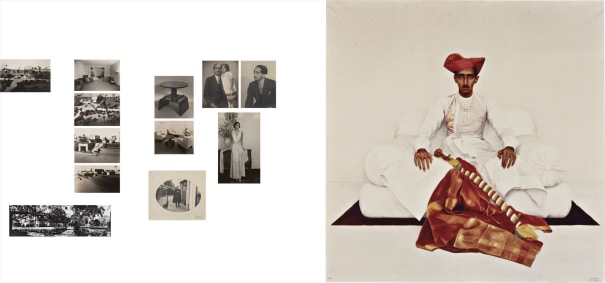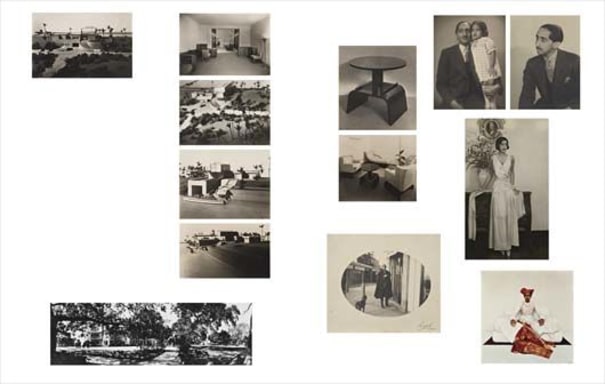Property from a Private Collection Eckart Muthesius Important sideboard, designed for the Maharaja of Indore's Banquet Hall, Manik Bagh (Garden of Rubies) Palace, Indore circa 1931 Stained American walnut, sycamore, aluminium. 94.8 x 299.8 x 51 cm (37 3/8 x 118 x 20 1/8 in.) Executed by Tischlerei Johann Eckel, Berlin-Lankwitz, Germany. Bow of key modelled with the Maharaja's monogram YH.
Provenance Maharaja Yeshwant Rao Holkar II of Indore, Manik Bagh Palace, Indore, India Acquired from the above, private collection, 1980s Thence by descent to the present owner Literature 'Indisches Märchenschloß 1933, Eine Berliner Architekt baut den Palast des Maharadschas von Indore', Berliner Illustrierte Zeitung, no. 46, November 1933, n.p. for the sideboard in situ Agnolodomenico Pica, 'Eckart Muthesius in India, The avant-garde meets history', Domus, no. 593, April 1979, p. 7 for the sideboard in situ Patricia Bayer, Art Deco Interiors, London, 1990, pp. 138-39 for the sideboard in situ Costantin Brancusi 1876-1957, exh. cat., Musée National d'Art Moderne, Centre Pompidou, Paris, 1995, p. 272 for the sideboard in situ Reto Niggl, Eckart Muthesius 1930: The Maharaja's Palace in Indore, Architecture and Interior, Stuttgart, 1996, p. 82 for the sideboard in situ Reto Niggl, Eckart Muthesius India, 1930-1939, Berlin, 1999, p. 58 for the sideboard in situ Le Palais Du Maharadjah D'Indore, photographs, exh. cat., Galerie Doria, Paris, 2006, pp. 63, 65, 107 for the sideboard in situ Amin Jaffer, Made for Maharajas, A Design Diary of Princely India, London, 2006, p. 267 for the sideboard in situ Catalogue Essay Phillips wishes to thank Vera Muthesius for her assistance with the cataloguing of the present lot. Yeshwant Rao Holkar II and the Palace of Ideas Deepika Ahlawat The Holkars of Indore were the regional representatives of the vast Maratha Empire which had caused dramatic change in Indian politics, society and culture in the 18th century. Founded by the warrior king Shivaji as a new political order in the late 17th century, the Marathas carved a confederacy, which at its peak controlled a bigger swathe of the subcontinent than any preceding empire. A concatenation of political circumstance and conflict broke the back of the Maratha confederacy within a century of its formation, but powerful regional generals, amongst them the Gaekwads of Baroda, the Scindias of Gwalior and the Holkars of Indore, continued as influential regional powers in central and western India. By the early 19th century, most Maratha houses had signed treaties of paramountcy with the East India Company, which allowed them to have a degree of independence as ‘native chiefs’ within their states. The Holkars found it difficult to live under this indirect rule of the British, and many rulers from the dynasty had fractious relationships with the Paramount Power. For example, Yeshwant Rao Holkar II (1908-1961) only became the Maharaja of Indore after his father, Tukojirao Holkar II, was deposed and exiled to France in 1926, the second successive ruler to be thus relieved of power. His son assumed full ruling powers at the age of 22 upon his return from England in 1930. After spending his early childhood in India, Yeshwant Rao had been sent to England to be educated: first at Charterhouse and then at Oxford. It is here, and on his travels to Europe and America, that he acquired his celebrated avant-garde taste. Under the influence of friends like Eckart Muthesius whom he had met at Oxford, he became an early patron of Modernism, including a collector of the works of the sculptor Constantin Brancusi His wife, Sanyogita, to whom he had been married in 1924 at the age of 16, had also been educated in England by the Indore State so that she could prove a suitable companion for him. However, rather than preparing them for a life in India, this arrangement gave the royal couple a taste for the free, cosmopolitan life afforded by the European capitals, and a reluctance to return to the duty-filled and tradition-bound life in Indore. The young couple went on frequent tours abroad, becoming enthusiastic patrons of western artists, designers, jewellers and couturiers until the death of Maharani Sanyogita in 1937. However reluctant Yeshwant Rao was to stay in India, he did make a sustained effort to modernise his state, starting a series of public works including ro
Property from a Private Collection Eckart Muthesius Important sideboard, designed for the Maharaja of Indore's Banquet Hall, Manik Bagh (Garden of Rubies) Palace, Indore circa 1931 Stained American walnut, sycamore, aluminium. 94.8 x 299.8 x 51 cm (37 3/8 x 118 x 20 1/8 in.) Executed by Tischlerei Johann Eckel, Berlin-Lankwitz, Germany. Bow of key modelled with the Maharaja's monogram YH.
Provenance Maharaja Yeshwant Rao Holkar II of Indore, Manik Bagh Palace, Indore, India Acquired from the above, private collection, 1980s Thence by descent to the present owner Literature 'Indisches Märchenschloß 1933, Eine Berliner Architekt baut den Palast des Maharadschas von Indore', Berliner Illustrierte Zeitung, no. 46, November 1933, n.p. for the sideboard in situ Agnolodomenico Pica, 'Eckart Muthesius in India, The avant-garde meets history', Domus, no. 593, April 1979, p. 7 for the sideboard in situ Patricia Bayer, Art Deco Interiors, London, 1990, pp. 138-39 for the sideboard in situ Costantin Brancusi 1876-1957, exh. cat., Musée National d'Art Moderne, Centre Pompidou, Paris, 1995, p. 272 for the sideboard in situ Reto Niggl, Eckart Muthesius 1930: The Maharaja's Palace in Indore, Architecture and Interior, Stuttgart, 1996, p. 82 for the sideboard in situ Reto Niggl, Eckart Muthesius India, 1930-1939, Berlin, 1999, p. 58 for the sideboard in situ Le Palais Du Maharadjah D'Indore, photographs, exh. cat., Galerie Doria, Paris, 2006, pp. 63, 65, 107 for the sideboard in situ Amin Jaffer, Made for Maharajas, A Design Diary of Princely India, London, 2006, p. 267 for the sideboard in situ Catalogue Essay Phillips wishes to thank Vera Muthesius for her assistance with the cataloguing of the present lot. Yeshwant Rao Holkar II and the Palace of Ideas Deepika Ahlawat The Holkars of Indore were the regional representatives of the vast Maratha Empire which had caused dramatic change in Indian politics, society and culture in the 18th century. Founded by the warrior king Shivaji as a new political order in the late 17th century, the Marathas carved a confederacy, which at its peak controlled a bigger swathe of the subcontinent than any preceding empire. A concatenation of political circumstance and conflict broke the back of the Maratha confederacy within a century of its formation, but powerful regional generals, amongst them the Gaekwads of Baroda, the Scindias of Gwalior and the Holkars of Indore, continued as influential regional powers in central and western India. By the early 19th century, most Maratha houses had signed treaties of paramountcy with the East India Company, which allowed them to have a degree of independence as ‘native chiefs’ within their states. The Holkars found it difficult to live under this indirect rule of the British, and many rulers from the dynasty had fractious relationships with the Paramount Power. For example, Yeshwant Rao Holkar II (1908-1961) only became the Maharaja of Indore after his father, Tukojirao Holkar II, was deposed and exiled to France in 1926, the second successive ruler to be thus relieved of power. His son assumed full ruling powers at the age of 22 upon his return from England in 1930. After spending his early childhood in India, Yeshwant Rao had been sent to England to be educated: first at Charterhouse and then at Oxford. It is here, and on his travels to Europe and America, that he acquired his celebrated avant-garde taste. Under the influence of friends like Eckart Muthesius whom he had met at Oxford, he became an early patron of Modernism, including a collector of the works of the sculptor Constantin Brancusi His wife, Sanyogita, to whom he had been married in 1924 at the age of 16, had also been educated in England by the Indore State so that she could prove a suitable companion for him. However, rather than preparing them for a life in India, this arrangement gave the royal couple a taste for the free, cosmopolitan life afforded by the European capitals, and a reluctance to return to the duty-filled and tradition-bound life in Indore. The young couple went on frequent tours abroad, becoming enthusiastic patrons of western artists, designers, jewellers and couturiers until the death of Maharani Sanyogita in 1937. However reluctant Yeshwant Rao was to stay in India, he did make a sustained effort to modernise his state, starting a series of public works including ro
.jpg)
.jpg)
.jpg)
.jpg)
.jpg)
.jpg)
.jpg)
.jpg)


.jpg)
.jpg)



Try LotSearch and its premium features for 7 days - without any costs!
Be notified automatically about new items in upcoming auctions.
Create an alert